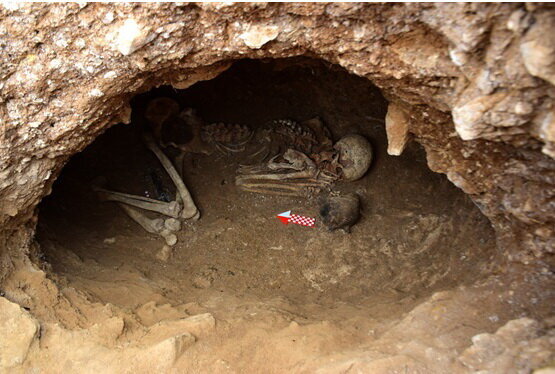Excavation sheds new light on ancient cemetery in northern Iran

TEHRAN – A team of Iranian archaeologists has recently finished the sixth archaeological season on the Liar-Sang-Bon, an archaeological site and cemetery in the Amlash region, northern Gilan province.
The recent surveys have shown that the type and size of graves in this cemetery may have indicated the social status or rank of the buried individuals, ISNA quoted Iranian archaeologist Vali Jahani as saying on Sunday.
In the cemetery section of the site, which covers an area of about two hectares, 19 graves (21 burials) of different types were identified during the recent excavation, he explained.
A large majority of graves do not have any special structural features, and the holes are oval, however, the size of these graves appears to vary depending on the social status of the deceased, he added.
He also noted that typological research generally suggests the tombs date from the middle of the Parthian period (247 BC – 224 CE) through the Sassanid era (224–651).
Various types of pottery and everyday objects, as well as weapons made of iron, were also discovered, he mentioned.
Back in January, DNA samples have been extracted from some ancient skeletons unearthed in Liar-Sang-Bon revealed that they date back to the Parthian and Sassanid periods.
Liar-Sang-Bon was initially identified in the Iranian calendar year 1391 (March 2012-March 2013) while its related mapping and demarcating projects were completed in 1393 and its first season of excavation commenced in 1395.
The site has undergone several archaeological surveys since then and the result has been the discovery of about 100 ancient tombs, a considerable number of historical objects, and very important information about the style and custom of burial of the people of that period.
However, the site was partly looted by antique seekers during a two-year gap in archaeological seasons.
Amlash, now a county in Gilan province, was a small village in southeastern Gilan in 1959. The name originates from the nearby Alborz valleys where archaeological artifacts were discovered during excavations. The artifacts range in date from the late second millennium BC through the Partho-Sasanian period, but most of the objects are dated to the 9th-8th century BC.
Dating and meaning of the known objects (bronze weapons and animal figurines, human statuettes of terra cotta and bronze, pottery animal effigy vases, and burnished black, gray, or orange pottery vessels) are complicated by insufficient archaeological contexts.
Bounded by the Caspian Sea and the Republic of Azerbaijan on the north, Gilan, in the far past, was within the sphere of influence of the successive Achaemenid, Seleucid, Parthian, and Sassanid empires that ruled Iran until the 7th century CE.
Sophisticated Rasht, capital of Gilan province, has long been a weekend escape for residents of Tehran who are looking to sample the famous local cuisine and hoping for some pluvial action – it's the largest, and wettest town in the northern region. Gilan is divided into a coastal plain including the large delta of Sefid Rud and adjacent parts of the Alborz mountain range.
ABU/AFM

Leave a Comment